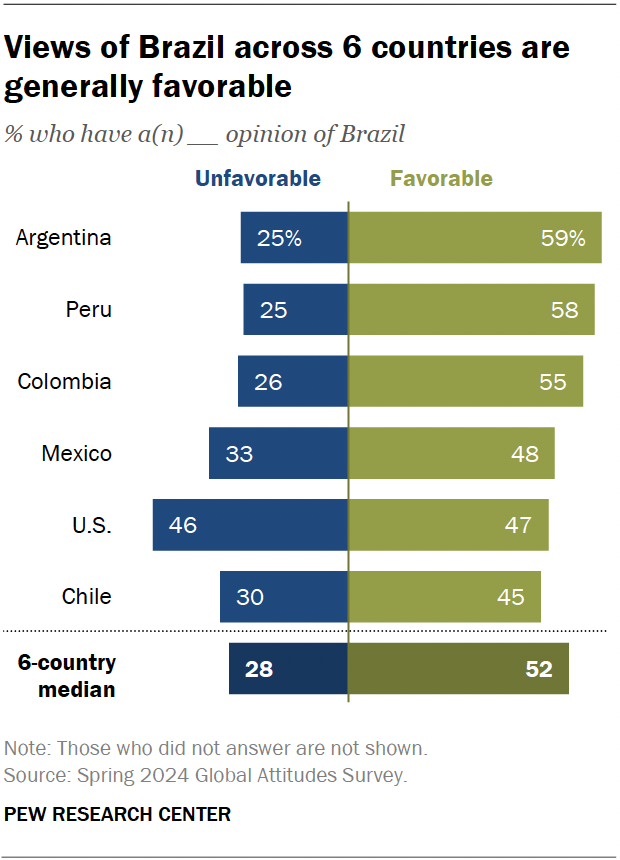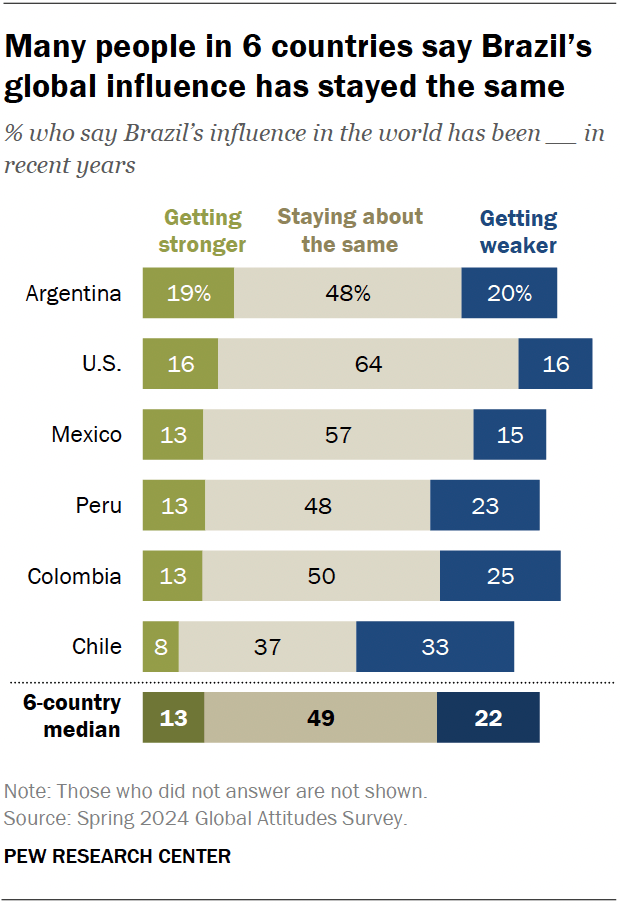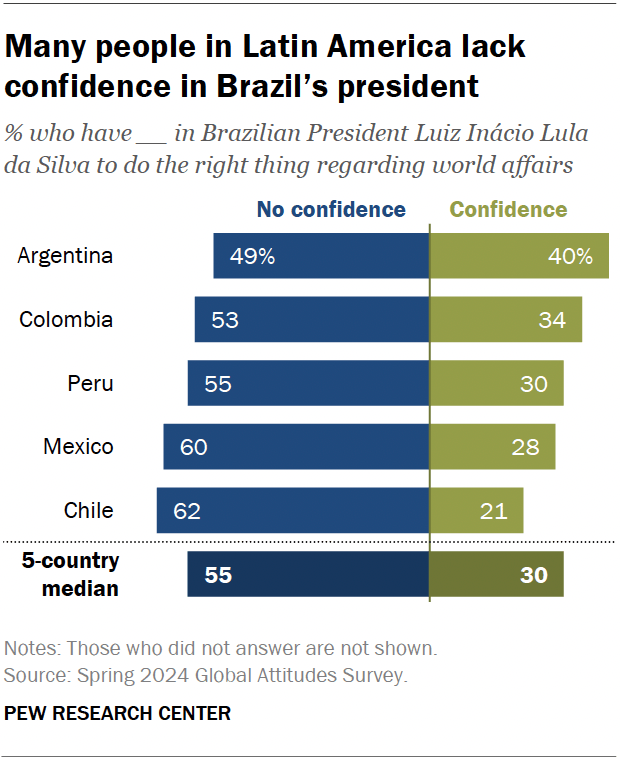In November, Brazil will host political leaders from around the world for the annual G20 summit – its first time presiding over the event. Ahead of the meeting, people in six countries across the Americas express generally favorable views of Brazil but lack confidence in its president, Luiz Inácio Lula da Silva.
Here are key findings about views of Brazil and Lula, based on Pew Research Center surveys conducted this spring in Argentina, Chile, Colombia, Mexico, Peru and the United States.
This Pew Research Center analysis examines public opinion of Brazil and President Luiz Inácio Lula da Silva in six countries ahead of the G20 summit in November. We looked at opinions in Argentina, Chile, Colombia, Mexico, Peru and the United States.
For non-U.S. data, this analysis draws on nationally representative surveys of 5,180 adults conducted from Jan. 22 to April 27, 2024. The surveys were conducted face-to-face.
In the United States, we surveyed 3,600 adults from April 1 to April 7, 2024. Everyone who took part in this survey is a member of the Center’s American Trends Panel (ATP), an online survey panel that is recruited through national, random sampling of residential addresses. This way nearly all U.S. adults have a chance of selection. The survey is weighted to be representative of the U.S. adult population by gender, race, ethnicity, partisan affiliation, education and other categories. Read more about the ATP’s methodology.
Throughout the analysis, we look at respondents’ attitudes based on where they place themselves on an ideological scale. We asked about political ideology using several slightly different scales and categorized people as being on the ideological left, center or right.
- In Argentina, Chile, Colombia, Mexico and Peru, we asked people to place themselves on a scale ranging from “Extreme left” to “Extreme right.”
- In the U.S., ideology is defined as conservative (right), moderate (center) and liberal (left).
To compare educational groups across countries, we standardized education levels based on the UN’s International Standard Classification of Education (ISCED). Prior to 2024, combined totals were based on rounded topline figures. For all reports beginning in 2024, totals are based on unrounded topline figures, so combined totals might be different than in previous years. Refer to the 2024 topline to see our new rounding procedures applied to past years’ data.
Here are the questions and responses used for the analysis, the survey methodology for non-U.S. surveys, and the survey methodology for the U.S. survey.
Views of Brazil across the Americas

Attitudes toward Brazil – the most populous country in South America and the seventh-most populous country in the world – are relatively positive. A median of 52% of adults across the six surveyed countries have a favorable opinion of Brazil, while 28% have an unfavorable opinion.
Argentines and Peruvians have the most positive views of Brazil, with about six-in-ten in each country holding a favorable opinion.
U.S. adults are the most likely to have a negative view of Brazil: 46% view it unfavorably, compared with no more than 33% in any of the other countries surveyed. Americans are also the most likely to provide an opinion.
In Chile, Colombia and Peru, we can analyze how views of Brazil have changed over time. In Chile and Peru, positive views of Brazil have decreased significantly since we last asked this question there in 2015. Favorability dropped from 78% to 45% among Chileans and from 68% to 58% among Peruvians. In contrast, Colombians’ opinions of Brazil have not changed significantly since 2014.
Opinions of Brazil are more favorable among younger adults in Chile, Colombia, Mexico, Peru and the U.S. For example, 68% of Colombians ages 18 to 34 hold a favorable view of Brazil, compared with 43% of adults ages 50 and older. Younger adults are also more likely to answer the question in these countries, except in the U.S.
In the U.S., Democrats and Democratic-leaning independents see Brazil more favorably than Republicans and Republican leaners do. Among Democrats, 54% hold a favorable view of Brazil, compared with 42% of Republicans.
Brazil’s international standing

When asked about Brazil’s influence in the world in recent years, many people in the U.S. and Latin America say it has stayed about the same. A median of 49% of adults across the six countries surveyed say this, but shares range from 64% in the U.S. to 37% in Chile.
A median of 22% say Brazil’s influence has weakened in recent years. A third in Chile say this, the highest share across the countries surveyed.
Few people overall (a median of 13%) say Brazil’s power is on the rise. No more than about one-in-five in any of the six countries surveyed say Brazil’s influence has strengthened in recent years.
In Argentina, Colombia and Mexico, people who have confidence in Lula are more likely than those with no confidence to say Brazil’s influence is getting stronger. Mexicans who lack confidence in Lula are less likely to express an opinion about Brazil’s influence in the world.
Related: Brazilians Mostly Optimistic About Country’s Global Standing Ahead of G20 Summit
Confidence in Lula across Latin America

Confidence in Lula to do the right thing regarding world affairs is relatively low across the Latin American countries surveyed. A median of 30% in these five countries express confidence in him, while a median of 55% do not. Confidence is lowest in Chile, where only 21% have confidence in Lula’s decision-making.
We asked this question for the first time in 2007, during Lula’s second term as president. Confidence in Lula was higher in Chile and Peru than it is now. In 2007, 49% of Chileans expressed confidence in Lula, but only 21% do so today. In Peru, confidence has dropped from 53% to 30% over the same period.
In some countries, confidence in Lula varies by certain demographic factors.
In Colombia, Mexico and Peru, people with more education express greater confidence in the Brazilian president than those with less education. For example, Colombian adults with more education are 15 percentage points more likely than their counterparts with less to express confidence in Lula. Colombians with more education are also more likely to answer the question.
Mexican and Peruvian adults who have incomes above the national median are more likely than those with lower incomes to have confidence in Lula. And in Argentina, those on the ideological left are more likely than those on the right to trust Lula.
Note: Here are the questions and responses used for the analysis, the survey methodology for non-U.S. surveys, and the survey methodology for the U.S. survey.

